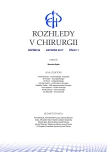-
Medical journals
- Career
Our experience with chest wall stabilization
Authors: M. Reška; I. Čapov; A. Peštál; J. Konečný; Z. Chovanec; V. Prudius; M. Benej; M. Páral; L. Veverková
Authors‘ workplace: I. chirurgická klinika LF Masarykovy univerzity a FN u svaté Anny v Brně přednosta: prof. MUDr. I. Čapov, CSc.
Published in: Rozhl. Chir., 2017, roč. 96, č. 11, s. 469-474.
Category: Original articles
Overview
Introduction:
An unstable chest wall is defined as a fracture of at least three adjacent ribs broken at least in two planes. As a result of impaired mechanical strength of the chest wall, paradoxical movements occur, resulting in insufficient pulmonary ventilation with the development of respiratory insufficiency with typical consequences – hypoxia, hypercapnia and acidosis.Methods:
In this paper we describe a group of 16 patients who underwent stabilization of the chest wall. The average age of the group was 56 years, the youngest patient was 23 and the oldest one 76 years old. There was an average of 6.1 broken ribs per patient, individually ranging from 4 to 8. In 11 cases, the stabilization was performed for a block fracture, in 5 cases for a serial fracture with a thoracic wall deformity.Results:
The average length of hospital stay was 19 days, the time from admission to surgery was 4.46 days, and the average duration of mechanical ventilation was 2.63 days. In our group, we had only one deep wound infection that was healed using vacuum therapy. Concerning other complications, there was one case of bronchopneumonia and one patient developed delirium. No redrainage for fluido - or pneumothorax was necessary.Conclusion:
The main focus of this paper is on the active surgical approach to treatment of serial and block fractures of ribs with deformation or manifest instability of the chest wall. Not all patients with block fracture required stabilization, whereas 5 patients with serial fracture of the ribs were indicated for surgical revision for chest wall deformity and other complications.Key words:
flail chest − treatment − indications
Sources
1. Molnar TF. Surgical management of chest wall trauma. Thoracic Surgery Clinics 2010;20 : 475−85.
2. Vyhnánek F, Skála P, Škrabalová D. Přínos multidetektorové výpočetní tomografie hrudníku k indikaci stabilizace hrudní stěny u blokové zlomeniny žeber: první zkušenosti. Acta Chir Orthop Traum Čech 2011;78 : 258−61.
3. Sirmali M, Turut H, Topcu S, et al. A comprehensive analysis of traumatic rib fractures: morbidity, mortality and management. Eur J Cardiothorac Surg 2003;24 : 133–8.
4. Voggenreiter G, Neudeck F, Aufmkolk M, et al. Operative chest wall stabilization in flail chest: outcomes of patients with or without pulmonary contusion. J Am Coll Surg 1998;187 : 130−8.
5. Richardson JD, Adams L Flint LM. Selective management of flail chest and pulmonary contusion. Ann Surg 1982;196 : 481−7.
6. Lardinois D, Krueger T, Dusmett M, et al. Pulmonary function testing after operative stabilization of the chest wall for flail chest. Eur J Cardiothorac Surg 2001;20 : 496−501.
7. Ahmed Z, Mohyuddin Z. Management of flail chest injury: internal fixation versus endotracheal intubation. J Thorac Cardiovasc Surg 1995;110 : 1676−80.
8. Mouton W, Lardinois D, Ferrer M, et al. Long-term follow-up of patients with operative stabilization of a flail chest. Thorac Cardiovasc Surg 1997;45 : 242−3.
9. Balci AE, Eren S, Cakir O, et al. Open fixation in flail chest: review of 64 patients. Asian Cardiovasc Thorac Ann 2004;12 : 11−5.
10. Granetzny A, El-Aal MA, Emam E, et al. Surgical versus conservative treatment of flail chest. Evaluation of the pulmonary status. Interact Cardiovasc Thorac Surg 2005;4 : 583–7.
11. Khandelwal G, Mathur RK, Shukla S, et al. A prospective single center study to assess the impact of surgical stabilization in patients with rib fracture. Int J Surg 2011;9 : 478–81.
12. Nirula R, Diaz Jr. JJ, Trunkey DD, et al. Rib fracture repair: Indications, technical issues, and future directions. World Journal of Surgery 2009;33 : 14–22.
13. Jing-Quing X, Pei-Li Q, Rong-Guo Y, et al. Better short-term efficacy of treating severe flail chest with internal fixation surgery compared with conservative treatments. Eur J Med Res 2015;20 : 55.
14. Chai X, Lin Q, Ruan Z, et al. The clinical application of absorbable intramedullary nail and claw plate on treating multiple rib fractures. Minerva Chir 2013;68 : 415–20.
15. Available from: http://www.akutne.cz/res/publikace/8stabilizace-hrudni-steny.pdf
16. Vyhnánek F, Jirava D, Očadlík M, et al. Chirurgická stabilizace u blokové zlomeniny žeber: indikace, technika a výsledky. Acta Chir Orthop Traum Čech 2015;82 : 303−7.
Labels
Surgery Orthopaedics Trauma surgery
Article was published inPerspectives in Surgery

2017 Issue 11-
All articles in this issue
- Damage control surgery in thoracic trauma
- History of thoracic stabilization
- Traumatic pneumothorax – diagnosis and treatment of 322 cases over a five-year period
- Penetrating chest trauma – experience of the Pilsen University Hospital Trauma Centre
- Our experience with chest wall stabilization
- Chest drain injury of the heart
- Initial experience with using uniportal VATS (SITS) to treat the implications of thoracic trauma in the 1st Department of Surgery of the Faculty of Medicine at Masaryk University and St. Anne’s Teaching Hospital in Brno
- Perspectives in Surgery
- Journal archive
- Current issue
- Online only
- About the journal
Most read in this issue- Traumatic pneumothorax – diagnosis and treatment of 322 cases over a five-year period
- Our experience with chest wall stabilization
- Damage control surgery in thoracic trauma
- Penetrating chest trauma – experience of the Pilsen University Hospital Trauma Centre
Login#ADS_BOTTOM_SCRIPTS#Forgotten passwordEnter the email address that you registered with. We will send you instructions on how to set a new password.
- Career

